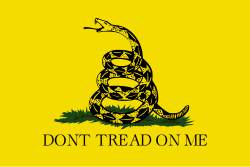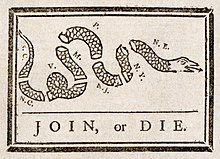Gadsden flag

The Gadsden flag is a historical American flag with a yellow field depicting a rattlesnake coiled and ready to strike. Positioned below the snake is the legend "Dont tread on me." The flag was designed by and is named after American general and statesman Christopher Gadsden. It was also used by the United States Marine Corps as an early motto flag.
Snake symbolism
The timber rattlesnake and eastern diamondback rattlesnake both populate the geographical areas of the original thirteen colonies. Their use as a symbol of the American colonies can be traced back to the publications of Benjamin Franklin. In 1751, he made the first reference to the rattlesnake in a satirical commentary published in his Pennsylvania Gazette. It had been the policy of Britain to send convicted criminals to America, so Franklin suggested that they thank the British by sending rattlesnakes to England.[1]

In 1754, during the French and Indian War, Franklin published his famous woodcut of a snake cut into eight sections. It represented the colonies, with New England joined together as the head and South Carolina as the tail, following their order along the coast. Under the snake was the message "Join, or Die". This was the first political cartoon published in an American newspaper.
As the American Revolution grew, the snake began to see more use as a symbol of the colonies. In 1774, Paul Revere added it to the title of his paper, the Massachusetts Spy, as a snake joined to fight a British dragon.[2] In December 1775, Benjamin Franklin published an essay in the Pennsylvania Journal under the pseudonym American Guesser in which he suggested that the rattlesnake was a good symbol for the American spirit:
"I recollected that her eye excelled in brightness, that of any other animal, and that she has no eye-lids—She may therefore be esteemed an emblem of vigilance.—She never begins an attack, nor, when once engaged, ever surrenders: She is therefore an emblem of magnanimity and true courage.—As if anxious to prevent all pretensions of quarreling with her, the weapons with which nature has furnished her, she conceals in the roof of her mouth, so that, to those who are unacquainted with her, she appears to be a most defenseless animal; and even when those weapons are shewn and extended for her defense, they appear weak and contemptible; but their wounds however small, are decisive and fatal:—Conscious of this, she never wounds till she has generously given notice, even to her enemy, and cautioned him against the danger of stepping on her.—Was I wrong, Sir, in thinking this a strong picture of the temper and conduct of America?"[3]
Gadsden's flag
The Albany conference was held on the verge of the war (June 19-July 11, 1754). The war was not declared until May 16 of 1756- almost 2 years later. Battles did take place before the war was declared (ex: Monongahela-July 9, 1755 and the battle of Jumonville Glen-April of 1754), but England did not declare the actual war (French and Indian or Seven Years War) during the Albany Conference.[4][5]

In fall 1775, the United States Navy was established to intercept incoming British ships carrying war supplies to the British troops in the colonies. To aid in this, the Second Continental Congress authorized the mustering of five companies of Marines to accompany the Navy on their first mission. The first Marines that enlisted were from Philadelphia and they carried drums painted yellow, depicting a coiled rattlesnake with thirteen rattles, and the motto "Don't Tread On Me." This is the first recorded mention of the future Gadsden flag's symbolism.
At the Congress, Continental Colonel Christopher Gadsden represented his home state of South Carolina. He was one of three members of the Marine Committee who were outfitting the first naval mission.[6]
Before the departure of that first mission, the newly appointed commander-in-chief of the Navy, Commodore Esek Hopkins, received the yellow rattlesnake flag described above from Gadsden to serve as his distinctive personal standard.
Gadsden also presented a copy of this flag to the South Carolina legislature in Charleston, South Carolina. This was recorded in the South Carolina congressional journals:
Col. Gadsden presented to the Congress an elegant standard, such as is to be used by the commander in chief of the American navy; being a yellow field, with a lively representation of a rattle-snake in the middle in the attitude of going to strike and these words underneath, "Don't Tread on Me!"[7]
Contemporary significance
Considered one of the first flags of the United States, the flag was later replaced by the current Stars and Stripes (or Old Glory) flag. Since the Revolution, the flag has seen times of reintroduction as a symbol of American patriotism, a symbol of disagreement with government, or a symbol of support for civil liberties.

For instance, unofficial usage of the Gadsden flag by the U.S. government has been seen, particularly in the wake of September 11, 2001, most notably by the Customs Service and harbor patrol boats in U.S. ports and individuals serving abroad in the U.S. military.[citation needed] The First Navy Jack, which was directly related to the Gadsden flag, has also been in use by the U.S. Navy, and since the terrorist attack on the WTC and pentagon, on all active naval ships.[citation needed] The rattlesnake from the flag is shown on the U.S. Army's Drill Sergeant Identification Badge.
Athletic apparel company Nike uses the image of a snake coiled around a soccer ball for an ongoing, patriotic "Don't Tread On Me" campaign in support of the United States men's national soccer team. The phrase has become a rallying cry for American soccer fans and the Gadsden flag can occasionally be seen at national team games. A representation of the rattlesnake is contained on the inside of their uniforms to be used in the 2010 World Cup.[8] The Philadelphia Union Major League Soccer expansion team, set to play in 2010, incorporated the coiled snake into its logo that was unveiled in May, 2009.[citation needed]
The flag appears in the Disney animated television series Recess, raised above the home of the character Gustav, whose father is a Marine. It is seen in the first episode's segment "The New Kid," which addresses individuality and tyranny.
For historical reasons, the flag is still popularly flown in Charleston, South Carolina, being the city where Christopher Gadsden first presented the flag, and where it was commonly used during the revolution, along with the blue and white crescent flag of pre-Civil War South Carolina. It also appears in a historical context in the 2000 film The Patriot in Charleston and in battle alongside the Old Glory flag. Metallica used the flag on their self-dubbed "Black Album" as a song name ("Don't Tread on Me"), and on the cover of the album, the snake from the flag is in the lower right hand corner. 311's eighth studio album is titled Don't Tread on Me released 2005. The New Jersey based punk rock group Titus Andronicus features one on the cover of their self-titled album, and the flag is frequently seen with them on tour. The flag has also been used as a critical prop in several movies and TV shows, such as in the final episode of Jericho, where it was flown to signal the titular town's independence.
Tea Party symbol
Beginning in 2009, the Gadsden Flag has become an adopted symbol of the American Tea Party movement.[9][10] Nationwide it serves as an alternative to the stars and stripes[11] for Tea Party protesters upset at the current government yet still feeling patriotic. [12] It was also seen being displayed by members of Congress at Tea Party rallies.[13] Some lawmakers have dubbed it a political symbol due to the Tea Party connection,[11] and the political nature of Tea Party supporters.[14]
References
- ^ Leepson, Marc; DeMille, Nelson (2006-05-30). Flag: An American Biography. Macmillan. pp. 12–. ISBN 9780312323097. Retrieved 13 July 2010.
- ^ "A More Perfect Union: Symbolizing the National Union of States". Library of Congress. Retrieved 2006-12-07.
- ^ Franklin, Benjamin. Pennsylvania Journal. December 27, 1775
- ^ From Resistance to Revolution
- ^ Prof. Debbie Marinski PHD at Ohio University
- ^ Our flag number: with 1197 flags in full colors and 300 additional illustrations in black and white. National Geographic Society. 1917. p. 289. Retrieved 23 October 2010.
{{cite book}}: Unknown parameter|coauthors=ignored (|author=suggested) (help) - ^ Hicks, Frederick Cocks (1918). The flag of the United States. United States Government Printing Office. p. 23.
- ^ "USA Men's Soccer Kit".
- ^ "Gadsden flag denied over State Capitol | wtnh.com Connecticut". Wtnh.com. Retrieved 2010-08-02.
- ^ "Gadsden Flag Now Officially "Offensive" In America". Aipnews.com. Retrieved 2010-08-02.
- ^ a b "Connecticut Marines Fight for 'Don't Tread on Me' Flag Display". FOXNews.com. 2010-04-07. Retrieved 2010-08-02.
- ^ "Flag daze - The Boston Globe". Boston.com. 2010-06-13. Retrieved 2010-08-02.
- ^ "Gadsden Flags Flying Off the Shelves in Support of the Tea Party Tax Protest". Market Wire. Retrieved 2009-07-07.
- ^ "Tea Party flag will not fly at Connecticut Capitol". Necn.com. 2010-04-08. Retrieved 2010-08-02.
External links
Template:Wikipedia-Books
![]() Media related to Gadsden flag at Wikimedia Commons
Media related to Gadsden flag at Wikimedia Commons
- The Gadsden Flag — An extensive history of the Gadsden flag and rattlesnake symbol.
- "A Flag of Conviction", The Claremont Institute
- "Gadsden Riders" A group of motorcyclists who love and respect the meaning and history of the Gadsden Flag.
